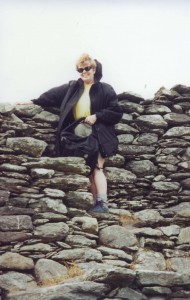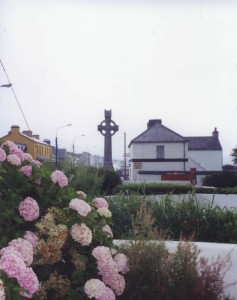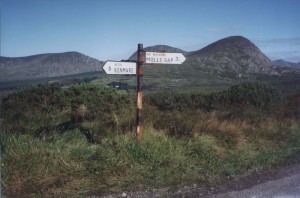Discovering Mythic Ireland
In September 1995, I found myself on a mist-shrouded beach in County Kerry, Ireland. My  sister Cheryl and I were spending a few days hiking the Ring of Kerry. That morning we were supposed to be hiking in the highlands, but it was a stormy day, and the wind was so strong that the trails were closed. Instead we stuck to lower ground.
sister Cheryl and I were spending a few days hiking the Ring of Kerry. That morning we were supposed to be hiking in the highlands, but it was a stormy day, and the wind was so strong that the trails were closed. Instead we stuck to lower ground.
The beach was deserted except for our small group of hikers. Holiday season was over, the food stalls were shuttered. A light rain fell. It was a rather lonely and dreary place.
Then our tour guide told us the story of Tir-Na-N-Og. The phrase means country of the young, and like other mythic spots like Shangri-la, no one grew old there. It was a favorite haunt of the fairies. Only one man ever saw the place, the bard and hero Oisin, who wandered there on his white horse guided by a Fairy. He stayed three hundred years. He then returned to the world of man to find his friends. Oisin galloped along the beach on which we stood. But then his foot touched the earth, and in an instant the horse disappeared and he fell to the ground an old man.
As our guide told the story, you could almost see the white horse and rider emerging from the mists off the sea.
I think it was then that I realized that it might be possible to find the locations of the great mythic events of Ireland, not just the legends of the heroes of the Celts, but the earlier tales told in the Book of Invasions — stories of monsters with one arm and one leg who came out of the sea, evil giants with one eye that could strike you dead, and most important of all, the Tuatha de Danaan, the people of light who eventually were defeated by the Celts and who disappeared to the sidhe, to become the Little People, the fairies of Irish Folk Tales.
I’d known about the giant mound near Sligo said to contain the tomb of the Celtic warrior queen Maeve. Archaeologists have been itching to dig there forever, but the locals won’t allow it. And Tara, the seat of the high kings of Ireland is there for anyone to see, not far from Newgrange, one of the most interesting ancient structures in the world.
But suddenly the Paps of Anu, two mountain peaks that had been merely directional markers during our hikes, became the home of the ancient goddess Anu, or Danu. The Sliab Mish mountains seen only dimly across the water on the Dingle Peninsula became home to Eriu, one part of the triple goddess of ancient Ireland, the one who gave her name to the island as Erin, and the site of a great battle between the Celts and the Tuatha de Danaan.
 The Book of Invasions tells the story of waves of successive invaders of Ireland. The Fomorians were among the first to arrive. Then later came Partholan, who defeated the Fomorians at the battle of Meg Itha. But then Partholan and his people died of plague in a place called Elta Edar near present day Dublin. The Nemedians came next, but they were defeated by the Fomorians who had regrouped. The Fomorians ruled Ireland from a glass tower that is supposed to have been on what is now Tory Island in the north.
The Book of Invasions tells the story of waves of successive invaders of Ireland. The Fomorians were among the first to arrive. Then later came Partholan, who defeated the Fomorians at the battle of Meg Itha. But then Partholan and his people died of plague in a place called Elta Edar near present day Dublin. The Nemedians came next, but they were defeated by the Fomorians who had regrouped. The Fomorians ruled Ireland from a glass tower that is supposed to have been on what is now Tory Island in the north.
Then came the greatest of pre-Celtic invaders, the Tuatha de Danaan, children of the great goddess Danu, who came from magical cities bearing special gifts, arriving on Beltane, May 1. The Book of Invasions tells the story of two great mythic battles between the Tuatha de Danaan and the dreaded Fomorians and another race called the Firbolg, the battles of Meg Tuired. Once I discovered how to pronounce those two words, I realized that Moytura, on today’s maps, was the site of one of those battles. The second is said to have taken place at Cong on Samain or November 1, and you can find that place today too.
The Tuatha de Danaan ruled Ireland until the arrival of the Sons of Mil, or the Celts. Ith, one of the Milesians met the de Danaan Kings at Aileach in what is now County Donegal. Ith rhapsodized about the beauty of the land, and the de Danaan’s believed he intended to capture it, so Ith was killed. A great battle ensued at Telltown, the de Danaans were defeated and retreated to the sidhe, and Ireland belonged, from then on, to the Celts.
The first Celt to touch Irish soil was not Ith, however, but a file, or druid, called Amairgen. There is a very famous spell Amairgen is said to have chanted when he stepped on Irish soil. Professor David A. Wilson of the University of Toronto helped me get a copy of the original Old Irish version of the spell, and Harry Roe, who is, incidentally, the spouse of fellow Canadian crime writer Caroline Roe, was kind enough to give me an original translation. Harry’s translation forms the first set of clues in The Celtic Riddle.
The second set of clues has more to do with the location of the ancient mythic sites. Every trip to Ireland I try to find and visit more of these mythic sites. Each of the provinces of Ireland – Munster, Connaught, Leinster, and Ulster – had a special goddess and a site sacred to her. For example, Munster had Aine, a love goddess of sorts, or a moon goddess according to Robert Graves, and perhaps related to or the same as Anu or Danu. Her home is Cnoc Aine, or in present terms Knockainy, Hill of Aine. Connaught had Maeve, as already mentioned, and Leinster had Almu, whose home is in the White Mountains. There were evil goddesses, too – Emain Macha, an archaeological site at Navan Fort in Ulster would have been home to one of them, Macha, the crow. There was also Tailtiu, or the daughter of the King of the Land of the Dead. She too has a sacred place now called Telltown, site of the final battle between the Tuatha de Danaan and the Celts. Many of the clues in The Celtic Riddle make reference to the ancient goddesses and their sacred places.
One of the most interesting books I’ve read on the mythic sites in Michael Dames’ Mythic Ireland. He proposes a network of mythic sites linked along solar lines. I am no expert on solar events, but his theory has some resonance when you see Newgrange in the Boyne Valley where, like Stonehenge and other ancient world monuments, the entranceway is aligned with the rising sun at the solstice. Some of the second set of clues are based on his network of mythic sites. One of the ancient sites I was looking for remained elusive, despite the fact I’d read reports on archaeological digs in the vicinity, until I read this book. It would spoil the story to tell you which one, but the site as described in the ancient tales can be seen today and the archaeological research may well support its importance in ancient times, a subject upon which Dames speaks eloquently. While little known by the Irish today, it has played a role in much more contemporary Irish history, a meeting place for those fighting for Irish independence.
